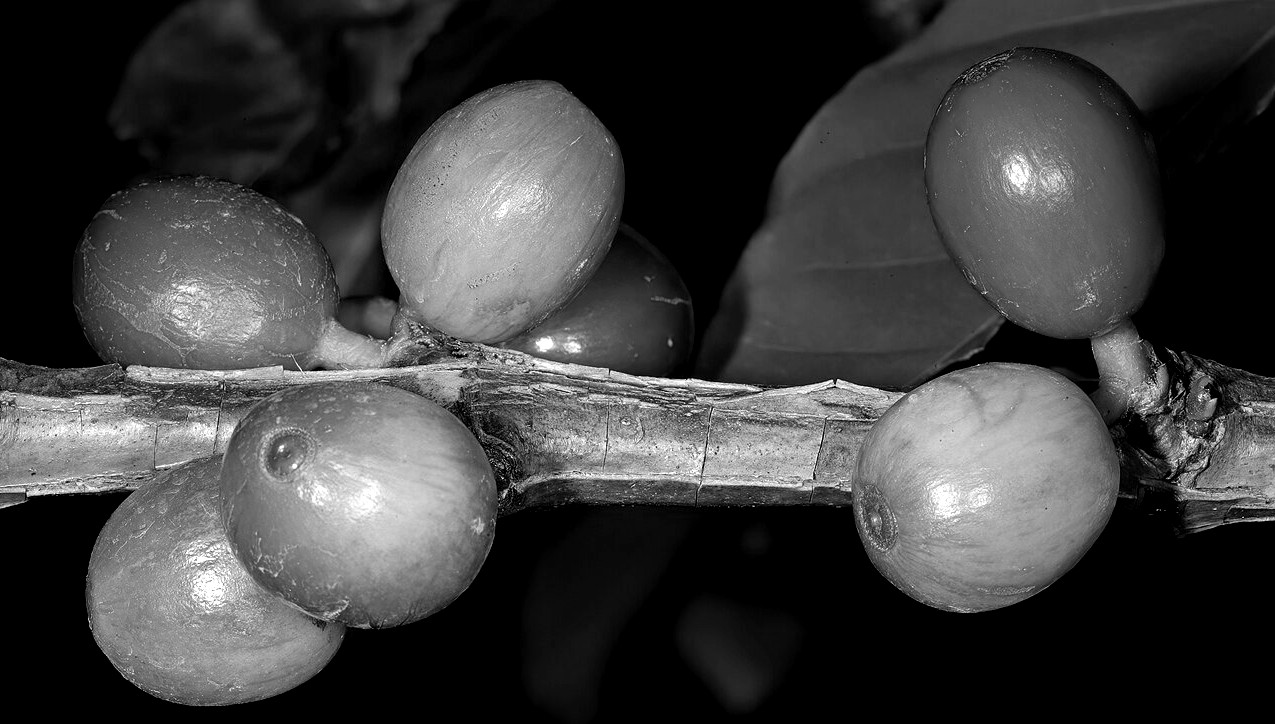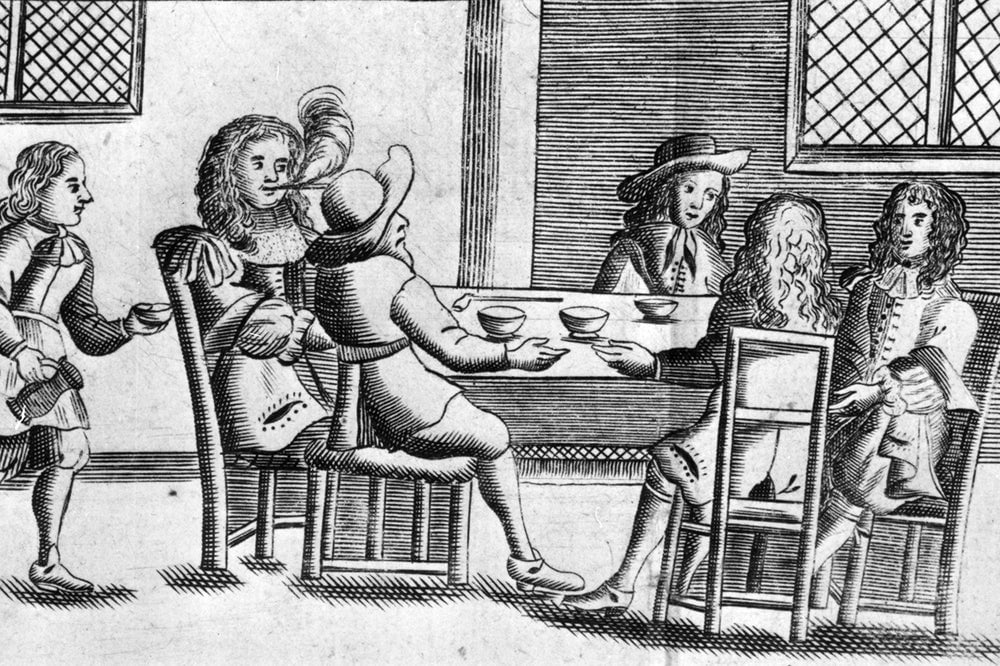Discover legendary Baba Budan and the seven coffee seeds from Arabia that started the aromatic journey of Indian coffee. It is a legend of danger and intrigue about the Indian Sufi Baba Budan who risked everything to smuggle seven coffee seeds from to Mysore, today Chandragiri in the Western Ghats of India.
In this Article
LEGEND: Baba Budan and the seven coffee seeds from Arabia
Baba Budan, a Sufi mystic named Hazrat Shah Jamer Allah Mazarabi (or Hazarat Shah Janab Magatabi), is said to have smuggled alive coffee beans from Mocha to India when he returned from the Hadj – pilgrimage to Mecca.

While traveling home through the port of Mocha in Yemen, Baba Budan enjoyed kahwa (Arabic for coffee) and learned as much as possible about the beverage. As well as the process from bean to cup.
He procured seven seeds – seven, a sacred number – which he hid in his beard and in his walking stick. Some say he tied a few to his belly with a cloth and smuggled the cherries out of Arabia.
Near the caves where he and his followers had settled, Baba planted the coffee fruits and grew the first Arabica plants in Mysore (today’s Karnataka) on the slopes of the Chandragiri. (Giri means hill).
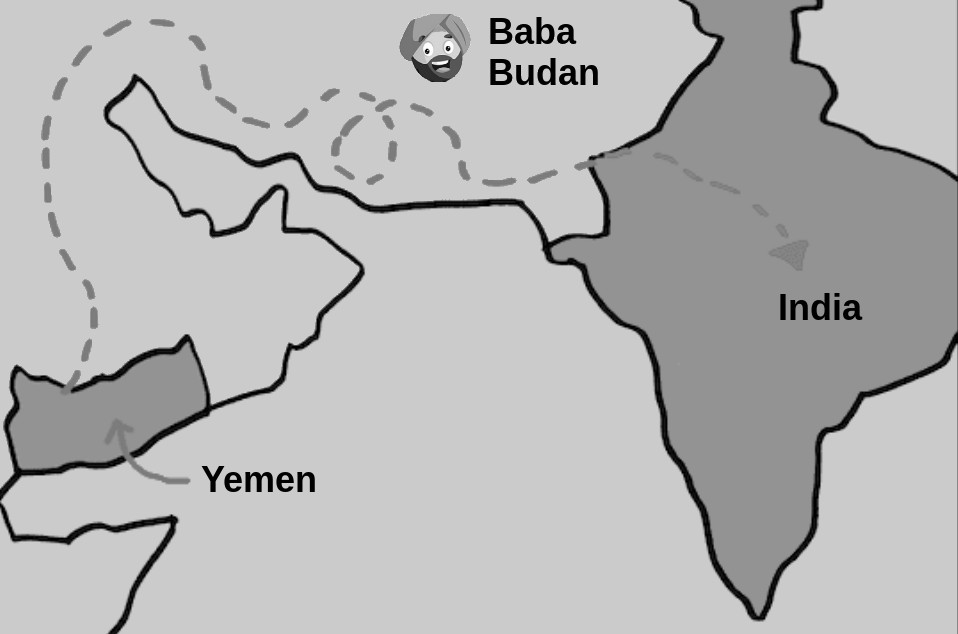
An early date of 1385 has been given for the occurrence, but Baba Budan probably went to India no earlier than 1600 and more likely about 1690.
Legend has it that Baba Budan broke the Arab monopoly over the coffee trade. A dangerous undertaking, the penalty for smuggling raw seeds was death. Only roasted coffee was traded through the port of Mocha in order to ensure control over the precious beans from Yemen.
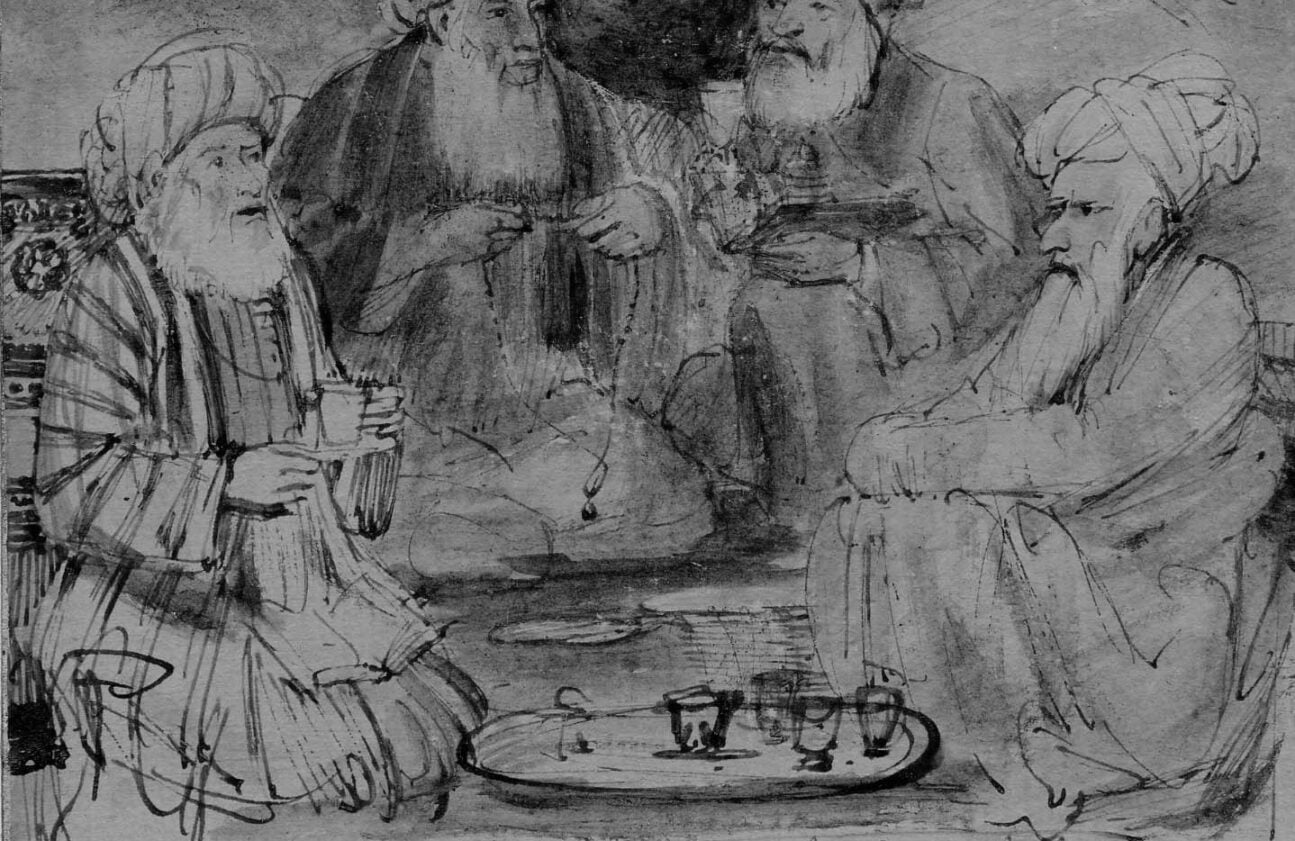
Sri Guru Dattatreya Baba Budangiri Temple

Today, coffee is still grown in these hills, and the area is known as Baba Budangiri. With an altitude of 1895 meters, it is the second-highest peak in Karnataka, and due to its natural crescent moon shape, it is also called Chandra Drona Parvat Shreni Mountain Range and Dattagiri (the hill of saint Dattatreya).
The mountain is famous for the shrine, or dargah (grave), of Sufi Saint Baba Budan also referred to as The Sri Guru Dattatreya Baba Budan Swamy Dargah, or Inam Dattatreya Peetha. This holy place is equally revered by both Hindus and Muslims. Situated on the flat top of the hill, devotees offer their prayers in the cave-like structure.
The syncretic reverence appears to touch three distinct saints: 11th-century Sufi Hazarat Dada Hayath Mir Khalandar (or Abdul Azeez Macci), wandering Sufi Baba Budan and Sage Dattatreya, the paradigmatic monk and yogi.
The shrine – a confluence of Islamic Sufism and the Hindu Avadhuta tradition

Dada Hayath
Historical legends and beliefs have it that in the 11th century, Sufi Hazarat Dada Hayath Mir Khalandar was sent to India from Saudi Arabia in 1005 to spread the message of peace and the tradition of Sufism.
Dattatreya
Dattatreya is a Hindu god and sage believed to be the avatar of the Holy Divine Trinity Brahma, Vishnu and Shiva. The teachings of Dattatreya have emphasized being natural, being unencumbered by ritual, tradition, and denomination, loving nature, and leading a life of ahimsa (non-violence) towards all creatures. Sufi practice focuses on the renunciation of worldly things, the purification of the soul, and the mystical contemplation of God’s nature.
Sufi Dada Hayath and Sage Dattatreya are considered divine manifestations, therefore interconnected and a synthesis of Trimurti and Sufi culture. Sufism is known as Tasawwuf in the Muslim world.
Baba Budan is Hazrat Shah Jamer Allah Mazarabi
In the 17th century, Hazrat Shah Jamer Allah Mazarabi, a Sufi saint, arrived in the hills and started meditating in the same cave as Dattatreya. People believed him to be the incarnation of Dattatreya. Baba Budans history can be traced back to Baghdad, wandering to Chikkamagaluru via Malabar and Mangalore.
The devotees also refer to him as Syed Meran Baba and Jan-e-Pak Shaheed after he was killed in an ambush near the cave. He was buried inside the cave along with two other Sufis.
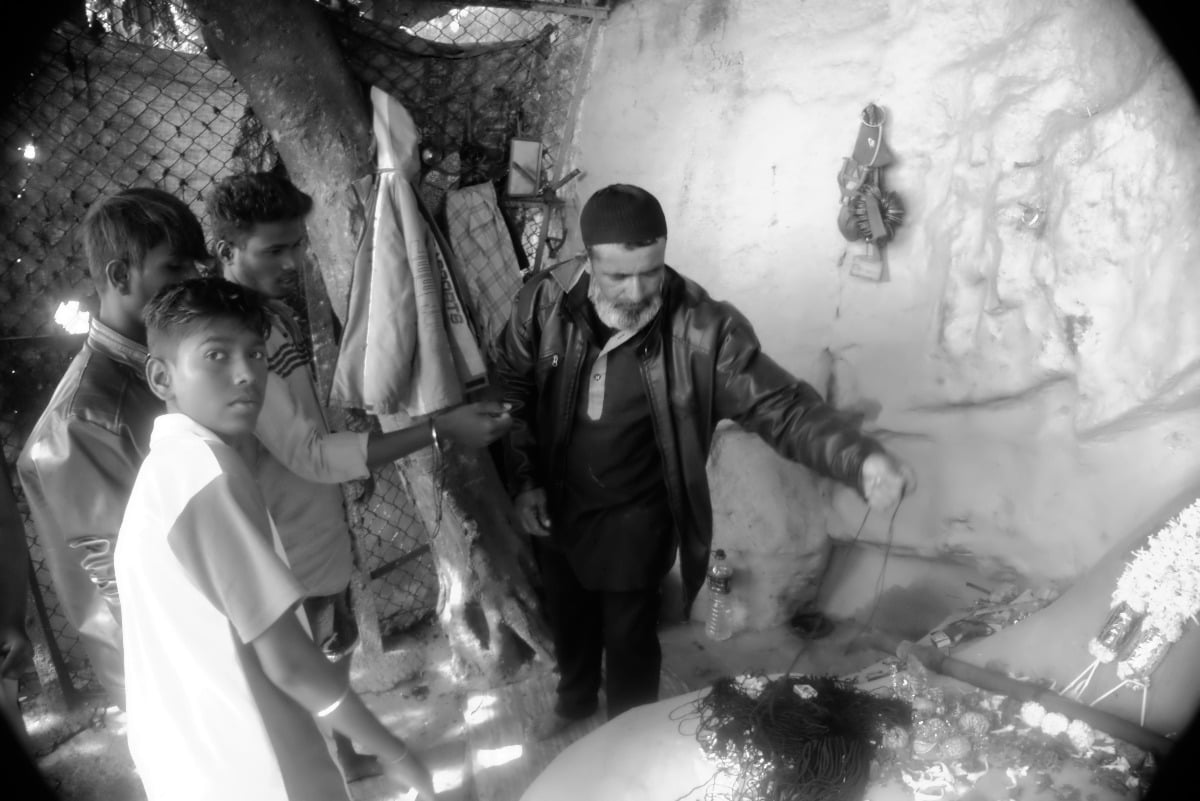
According to local beliefs, Lord Dattatreya is a part of the Awadhoot अवधूत tradition that supports the worship of one formless God and describes a people, who have passed beyond all worldly attachments and cares. The mystic Sufis Dada Hayath and Baba Budan became interchangeable, and the Dattatreya tradition and Sufism bear a syncretic identity.

The heritage and legacy of Baba Budan to Chickmagalur and Indian coffee culture
From Baba Budan’s seven seeds blossomed what is India’s coffee industry and culture today, forever transforming the country’s landscape.
Chickmagalur (also called Chikkamagaluru or Chikmagalore), famous for its undulating hills, lush greenery and tranquil surroundings, today is filled with coffee plantations throughout its length and breadth – it is the birthplace of India’s coffee.

Folklore suggests that Babas fruits were of the Arabica variety – or Mysore coffee, as it was once known. Coffea Arabica still grows here at higher elevations, and Coffea Canephora (Robusta) along the lower levels of the Baba Budan mountains.
Countless coffee estates are situated amidst the Western Ghats, a heavily forested area, where the coffee trees thrive. Karnataka is the largest producer of coffee in India, with over 70% of the country’s production grown here.
The most beautiful plantations are sprawling across Chikkamagaluru, Kodagu, and Hassan. Chikkamagaluru has a perpetual fragrance of coffee lingering in the air. The scent of coffee is the aroma of home-brewed memories and emotions, a fragrance both evocative and personal. That can transport you to a sprawling coffee house or a cozy breakfast with loved ones.

As we left Chikkamagaluru town and began our ascent into higher climes, there were surprises at every hairpin bend: towering peaks, delightful valleys, meandering rivers, sparkling streams, water falls and the invigorating mountain air.
Set against a smooth hilly backdrop, the Western Ghats are picturesque in the Malnad district. On a lower elevation, the Robusta is flowering and covered in white, as we gain height, colorful cherries from green, yellow and orange to crimson, adorn the trees, till the bumpy, winding road leads us to naked, freshly harvested trees.
We visited the hills with our friend Avnish during Arabica harvesting season in order to gain a deeper understanding of the local coffee culture – enjoying every sip of coffee knowledge we could get. Visiting Chikkamagalore and Baba Budanagiri, we have been sharing a coffee with friendly and curious locals.
Having a coffee in India means sharing stories and being part of a deeply cultural ritual starting with legendary Baba Budan and the seven coffee seeds from Arabia, that gave birth to the aromatic journey of Indian coffee.
Thank you Baba Budan for the rich and aromatic flavors of Indian coffee.
~ ○ ~
Keep exploring:
Works Cited & Multimedia Sources
The history of coffee is an extraordinary study. If you would like to learn more about it, we heartily recommend the book, All About Coffee, by William Ukers. Written in 1928, it is as good a book on coffee as has been written and will delight you with detail.
Also the new book Short History of Coffee, by Kerr Gordon is delightful.
Thank you Klaus Langrock for proof reading.
- Elliot R.H.The Experiences Of A Planter In The Jungles Of Mysore.
- Hakala Walter N. A Sultan in the Realm of Passion: Coffee in Eighteenth-Century Delhi. Eighteenth-Century Studies. 2014.
- https://www.middleeasteye.net/discover/india-coffee-lost-culture-mughal-empire
- http://www.teacoffeespiceofindia.com/coffee/coffee-origin
- https://bearessentialscoffee.co.uk/2020/05/29/coffee-tales-part-2-baba-budan-and-the-seven-seeds/
- https://blog.lovers.coffee/indian-coffee-indias-transition-from-tea-to-coffee/
- https://chikmagalurtourism.org.in/baba-budangiri-datta-peeta-chikmagalur
- https://digitalgems.nus.edu.sg/shared/colls/hisher/files/VoyMan.pdf
- https://economictimes.indiatimes.com/how-can-filter-coffee-be-so-different-yet-good/articleshow/22762503.cms?from=mdr
- https://en.wikipedia.org/wiki/Baba_Budan
- https://en.wikipedia.org/wiki/Baba_Budangiri
- https://food52.com/blog/25751-what-is-south-indian-filter-coffee
- https://isabelwrites.files.wordpress.com/2012/02/south-india-coffee-trail-in-silkwinds-oct-2015.pdf
- https://mediaindia.eu/freestyle/coffees-humble-roots-in-india/
- https://tattvamasiorganica.com
- https://theprint.in/india/datta-peetha-bababudangiri-how-karnatakas-hindu-muslim-shrine-became-ayodhya-of-the-south/786719/
- https://timesofindia.indiatimes.com/blogs/symphony-of-tastes/poetic-rendition-of-indian-coffee-house-alleppey-india-in-sonnet-style/
- https://web.archive.org/web/20160917181332/http://www.teacoffeespiceofindia.com/coffee/india-coffees-varieties
- https://whc.unesco.org/en/list/1342
- https://worldcoffeeresearch.org/focus-countries/india
- https://www.cntraveller.in/story/when-indian-coffee-house-was-the-countrys-living-room
- https://www.coffees.gr/baba-budan-story/?sl=en&s_layout=13
- https://www.deccanherald.com/india/karnataka/chroniclers-coffee-bean-2104866
- https://www.deccanherald.com/india/karnataka/chroniclers-coffee-bean-2104866
- https://www.firstpost.com/art-and-culture/a-short-history-of-the-india-coffee-house-conversation-revolutionary-politics-and-a-different-way-to-do-business-9184321.html
- https://www.folger.edu/blogs/shakespeare-and-beyond/islamic-history-of-coffee/
- https://www.kaapi.com.au/indian-filter-coffee
- https://www.madrasmusings.com/vol-31-no-1/coffee-and-the-city/
- https://www.masalakorb.com/south-indian-filter-coffee-filter-kaapi/
- https://www.masalakorb.com/south-indian-filter-coffee-filter-kaapi/
- https://www.middleeasteye.net/discover/india-coffee-lost-culture-mughal-empire
- https://www.researchgate.net/publication/360227425_ORIGIN_OF_COFFEE_IN_INDIA_A_MAJOR_INDUSTRY
- https://www.slowfood.com/the-story-of-coffee-in-india/
- https://www.thesouthindiancoffeehouse.com/gallery/
- Jonathan Morris. Coffee: A Global History. 2019.
- Lee Allen, Stewart. The Devil’s Cup: Coffee, the Driving Force in History, Soho. 1999.
- Mennell Stephen. All Manners of Food. Eating and Taste in England and France from the Middle Ages to the Present. 1995.
- Nagegowda Dr H.L. Bettadinda Battalige – Coffeeya kathe (Story of Coffee).
- Nirmala Lakshman, Degree Coffee by the Yard. 2013.
- R.K.Narayan’s. My Dateless Diary. 1960.
- Saasubilli Paradesi Naidu. Coffee Industry in India – A Historical Perspective. Journal
- Of Humanities And Social Science. 2018. https://iosrjournals.org/iosr-jhss/papers/Vol.%2023%20Issue8/Version-4/D2308042933.pdf
- Stephen Blake. Shahjhanabad: The Sovereign City in Mughal India, 1639–1739. 1991.
- Thakur Sankarshan. The Brothers Bihari Paperback. 2015.
- The Experiences Of A Planter In The Jungles Of Mysore
- The Voyages and Travels of J. Albert de Mandelslo. 1638. https://archive.org/stream/in.ernet.dli.2015.531053/2015.531053.mandelslos-travels_djvu.txt
- Vermani Neha. Spilling the Beans: The Islamic History of Coffee. https://themuslimtimes.info/2023/05/31/spilling-the-beans-the-islamic-history-of-coffee/
- Wild Antony. Coffee: A Dark History. 2005.
